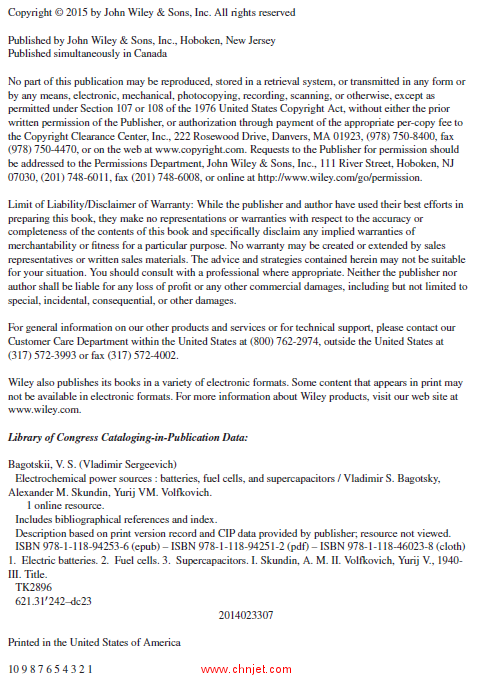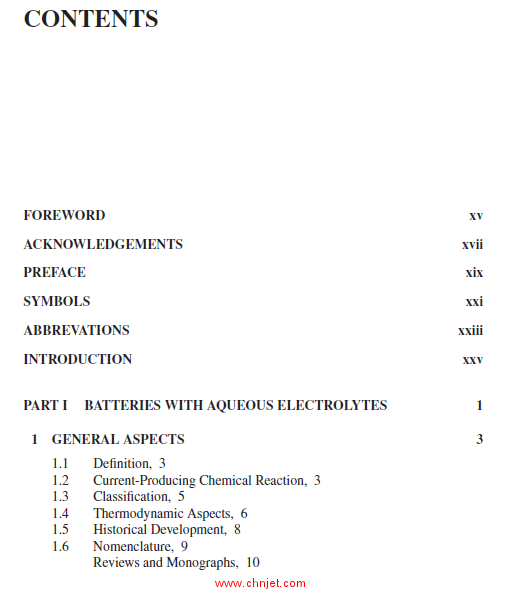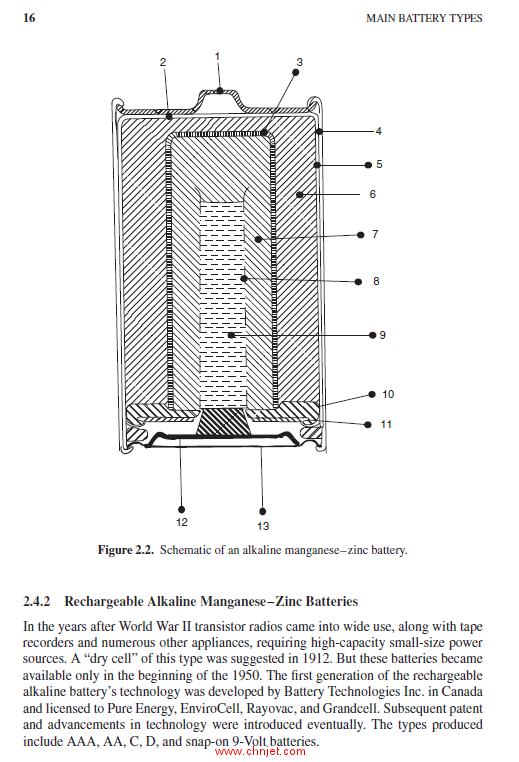马上注册,结交更多好友,享用更多功能,让你轻松玩转社区。
您需要 登录 才可以下载或查看,没有账号?立即注册

×
《Electrochemical Power Sources: Batteries, Fuel Cells, and Supercapacitors》
电化学电源:电池、燃料电池和超级电容器
作者:Vladimir S. Bagotsky, Alexander M. Skundin, Yurij M. Volfkovich
出版社:Wiley
出版时间:2015年
《Electrochemical Power Sources: Batteries, Fuel Cells, and Supercapacitors》

《Electrochemical Power Sources: Batteries, Fuel Cells, and Supercapacitors》

《Electrochemical Power Sources: Batteries, Fuel Cells, and Supercapacitors》

《Electrochemical Power Sources: Batteries, Fuel Cells, and Supercapacitors》

目录
FOREWORD xv
ACKNOWLEDGEMENTS xvii
PREFACE xix
SYMBOLS xxi
ABBREVATIONS xxiii
INTRODUCTION xxv
PART I BATTERIES WITH AQUEOUS ELECTROLYTES 1
1 GENERAL ASPECTS 3
1.1 Definition, 3
1.2 Current-Producing Chemical Reaction, 3
1.3 Classification, 5
1.4 Thermodynamic Aspects, 6
1.5 Historical Development, 8
1.6 Nomenclature, 9
Reviews and Monographs, 10
viii CONTENTS
2 MAIN BATTERY TYPES 11
2.1 Electrochemical Systems, 11
2.2 Leclanché (Zinc–Carbon) Batteries, 12
2.3 The Zinc Electrode in Alkaline Solutions, 14
2.4 Alkaline Manganese–Zinc Batteries, 14
2.5 Lead Acid Batteries, 17
2.6 Alkaline Nickel Storage Batteries, 20
2.7 Silver–Zinc Batteries, 23
References, 24
Monographs and Reviews, 25
3 PERFORMANCE 27
3.1 Electrical Characteristics of Batteries, 27
3.2 Electrical Characteristics of Storage Batteries, 30
3.3 Comparative Characteristics, 30
3.4 Operational Characteristics, 31
References, 32
4 MISCELLANEOUS BATTERIES 33
4.1 Mercury–Zinc Batteries, 33
4.2 Compound Batteries, 34
4.3 Batteries with Water as Reactant, 37
4.4 Standard Cells, 38
4.5 Reserve Batteries, 39
Reference, 41
Reviews and Monographs, 41
5 DESIGN AND TECHNOLOGY 43
5.1 Balance in Batteries, 43
5.2 Scale Factors, 44
5.3 Separators, 44
5.4 Sealing, 46
5.5 Ohmic Losses, 47
5.6 Thermal Processes in Batteries, 48
6 APPLICATIONS OF BATTERIES 51
6.1 Automotive Equipment Starter and Auxiliary Batteries, 51
6.2 Traction Batteries, 52
6.3 Stationary Batteries, 53
6.4 Domestic and Portable Systems, 53
6.5 Special Applications, 54
CONTENTS ix
7 OPERATIONAL PROBLEMS 55
7.1 Discharge and Maintenance of Primary Batteries, 55
7.2 Maintenance of Storage Batteries, 56
7.3 General Aspects of Battery Maintenance, 60
8 OUTLOOK FOR BATTERIES WITH AQUEOUS
ELECTROLYTE 63
References, 64
PARTII BATTERIES WITH NONAQUEOUS ELECTROLYTES 65
9 DIFFERENT KINDS OF ELECTROLYTES 67
9.1 Electrolytes Based on Aprotic Nonaqueous Solutions, 68
9.2 Ionically Conducting Molten Salts, 69
9.3 Ionically Conducting Solid Electrolytes, 70
References, 72
10 INSERTION COMPOUNDS 73
Monographs and Reviews, 76
11 PRIMARY LITHIUM BATTERIES 77
11.1 General Information: Brief History, 77
11.2 Current-Producing and Other Processes in Primary Power Sources, 79
11.3 Design of Primary Lithium Cells, 81
11.4 Fundamentals of the Technology of Manufacturing of Lithium
Primary Cells, 82
11.5 Electric Characteristics of Lithium Cells, 82
11.6 Operational Characteristics of Lithium Cells, 83
11.7 Features of Primary Lithium Cells of Different Electrochemical
Systems, 84
Monographs, 89
12 LITHIUM ION BATTERIES 91
12.1 General Information: Brief History, 91
12.2 Current-Producing and Other Processes in Lithium Ion Batteries, 93
12.3 Design and Technology of Lithium Ion Batteries, 96
12.4 Electric Characteristics, Performance, and Other Characteristics
of Lithium Ion Batteries, 98
12.5 Prospects of Development of Lithium Ion Batteries, 99
Monographs, 101
x CONTENTS
13 LITHIUM ION BATTERIES: WHAT NEXT? 103
13.1 Lithium–Air Batteries, 103
13.2 Lithium–Sulfur Batteries, 106
13.3 Sodium Ion Batteries, 108
Reviews, 110
14 SOLID-STATE BATTERIES 111
14.1 Low-Temperature Miniature Batteries with Solid Electrolytes, 111
14.2 Sulfur–Sodium Storage Batteries, 112
Monographs and Reviews, 115
15 BATTERIES WITH MOLTEN SALT ELECTROLYTES 117
15.1 Storage Batteries, 117
15.2 Reserve-Type Thermal Batteries, 120
References, 122
PARTIII FUEL CELLS 123
16 GENERAL ASPECTS 125
16.1 Thermodynamic Aspects, 125
16.2 Schematic Layout of Fuel-Cell Units, 128
16.3 Types of Fuel Cells, 131
16.4 Layout of a Real Fuel Cell: The Hydrogen–Oxygen Fuel Cell
with Liquid Electrolyte, 132
16.5 Basic Parameters of Fuel Cells, 134
Reference, 140
Monographs, 140
17 THE DEVELOPMENT OF FUEL CELLS 141
17.1 The Period prior to 1894, 141
17.2 The Period from 1894 to 1960, 143
17.3 The Period from 1960 to the 1990s, 144
17.4 The Period after the 1990s, 148
References, 149
Monographs and Reviews, 150
18 PROTON-EXCHANGE MEMBRANE FUEL CELLS (PEMFC) 151
18.1 The History of PEMFC, 151
18.2 Standard PEMFC Version of the 1990s, 154
18.3 Operating Conditions of PEMFC, 156
CONTENTS xi
18.4 Special Features of PEMFC Operation, 157
18.5 Platinum Catalyst Poisoning by Traces of Co in the Hydrogen, 159
18.6 Commercial Activities in Relation to PEMFC, 161
18.7 Future Development of PEMFCs, 162
18.8 Elevated-Temperature PEMFCs (ET-PEMFCs), 167
References, 170
Reviews, 170
19 DIRECT LIQUID FUEL CELLS WITH GASEOUS, LIQUID,
AND/OR SOLID REAGENTS 171
19.1 Current-Producing Reactions and Thermodynamic
Parameters, 172
19.2 Anodic Oxidation of Methanol, 172
19.3 Use of Platinum–Ruthenium Catalysts for Methanol
Oxidation, 173
19.4 Milestones in DMFC Development, 173
19.5 Membrane Penetration by Methanol (Methanol Crossover), 174
19.6 Varieties of DMFC, 176
19.7 Special Operating Features of DMFC, 178
19.8 Practical Prototypes of DMFC and Their Features, 180
19.9 The Problems to be Solved in Future DMFC, 181
19.10 Direct Liquid Fuel Cells (DLFC), 183
Reference, 188
Reviews, 188
20 MOLTEN CARBONATE FUEL CELLS (MCFC) 191
20.1 Special Features of High-Temperature Fuel Cells, 191
20.2 The Structure of Hydrogen–Oxygen MCFC, 192
20.3 MCFC with Internal Fuel Reforming, 194
20.4 The Development of MCFC Work, 195
20.5 The Lifetime of MCFCs, 196
References, 198
Reviews and Monographs, 198
21 SOLID OXIDE FUEL CELLS (SOFCs) 199
21.1 Schematic Design of a Conventional SOFC, 200
21.2 Tubular SOFCs, 201
21.3 Planar SOFCs, 202
21.4 Varieties of SOFCs, 205
21.5 The Utilization of Natural Fuels in SOFCs, 206
21.6 Interim-Temperature SOFCs (ITSOFCs), 208
21.7 Low-Temperature SOFCs (LT-SOFC), 211
21.8 Factors Influencing the Lifetime of SOFCs, 211
xii CONTENTS
References, 212
Monographs and Reviews, 212
22 OTHER TYPES OF FUEL CELLS 213
22.1 Phosphoric Acid Fuel Cells (PAFCs), 213
22.2 Redox Flow Fuel Cells, 218
22.3 Biological Fuel Cells, 221
22.4 Direct Carbon Fuel Cells (DCFCs), 224
References, 227
Monographs, 227
23 ALKALINE FUEL CELLS (AFCs) 229
23.1 Hydrogen–Oxygen AFCs, 230
23.2 Problems in the AFC Field, 233
23.3 The Present State and Future Prospects of AFC Work, 235
23.4 Anion-Exchange (Hydroxyl Ion Conducting) Membranes, 236
23.5 Methanol Fuel Cell with an Invariant Alkaline Electrolyte, 237
References, 237
Monograph, 237
24 APPLICATIONS OF FUEL CELLS 239
24.1 Large Stationary Power Plants, 239
24.2 Small Stationary Power Units, 242
24.3 Fuel Cells for Transport Applications, 243
24.4 Portables, 248
24.5 Military Applications, 250
References, 250
25 OUTLOOK FOR FUEL CELLS 251
25.1 Alternating Periods of Hope and Disappointment—Forever? 252
25.2 Development of Electrocatalysis, 252
25.3 “Ideal Fuel Cells” Do Exist, 253
25.4 Expected Future Situation with Fuel Cells, 255
Reference, 256
Monographs, 256
PARTIV SUPERCAPACITORS 257
26 GENERAL ASPECTS 259
26.1 Electrolytic Capacitors, 259
References, 261
CONTENTS xiii
27 ELECTROCHEMICAL SUPERCAPACITORS WITH CARBON
ELECTRODES 263
27.1 Introduction, 263
27.2 Main Properties of Electric Double-Layer Capacitors (EDLC), 264
27.3 EDLC Energy Density and Power Density, 267
27.4 Fundamentals of EDLC Macrokinetics, 271
27.5 Porous Structure and Hydrophilic–Hydrophobic Properties
of Highly Dispersed Carbon Electrodes, 272
27.6 Effect of Ratio of Ion and Molecule Sizes and Pore Sizes, 275
27.7 Effect of Functional Groups on EDLC Characteristics, 277
27.8 Electrolytes Used in EDLC, 279
27.9 Impedance of Highly Dispersed Carbon Electrodes, 283
27.10 Nanoporous Carbons Obtained Using Various Techniques, 286
27.11 High-Frequency Carbon Supercapacitors, 303
27.12 Self-Discharge of Carbon Electrodes and Supercapacitors, 306
27.13 Processes of EDLC Degradation (AGING), 311
References, 313
Monograph and Reviews, 313
28 PSEUDOCAPACITOR ELECTRODES AND
SUPERCAPACITORS 315
28.1 Electrodes Based on Inorganic Salts of Transition Metals, 315
28.2 Electrodes Based on Electron-Conducting Polymers (ECPs), 322
28.3 Redox Capacitors Based on Organic Monomers, 333
28.4 Lithium-Cation-Exchange Capacitors, 335
References, 337
Monograph and Reviews, 337
29 HYBRID (ASYMMETRIC) SUPERCAPACITORS (HSCs) 339
29.1 HSCs of MeOx/C Types, 339
29.2 HSCs of ECP/C Type, 343
References, 344
Review, 344
30 COMPARISON OF CHARACTERISTICS OF SUPERCAPACITORS
AND OTHER ELECTROCHEMICAL DEVICES. CHARACTERISTICS
OF COMMERCIAL SUPERCAPACITORS 345
Reference, 350
Reviews, 350
31 PROSPECTS OF ELECTROCHEMICAL SUPERCAPACITORS 351
xiv CONTENTS
32 ELECTROCHEMICAL ASPECTS OF SOLAR ENERGY
CONVERSION 355
32.1 Photoelectrochemical Phenomena, 355
32.2 Photoelectrochemical Devices, 356
32.3 Photoexcitation of Metals (Electron Photoemission into
Solutions), 356
32.4 Behavior of Illuminated Semiconductors, 357
32.5 Semiconductor Solar Batteries (SC-SB), 358
32.6 Dye-Sensitized Solar Cells (DSSC), 360
References, 363
Reviews and Monographs, 363
AUTHOR INDEX 365
SUBJECT INDEX 369
专业书籍
下载地址:(回复后可见)
|
![]()